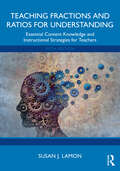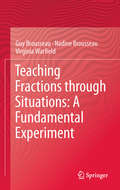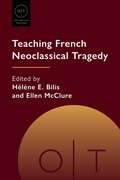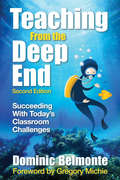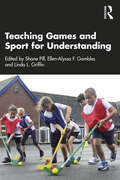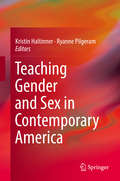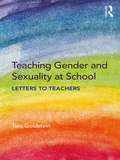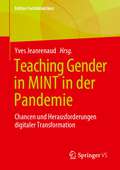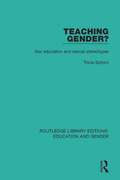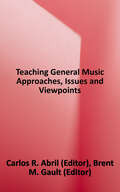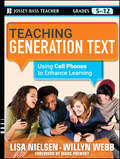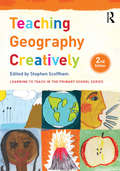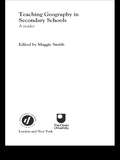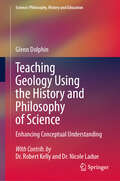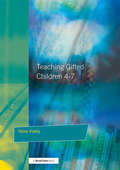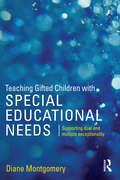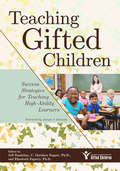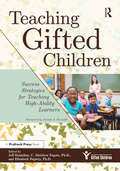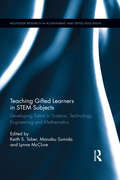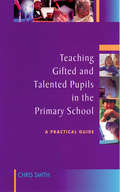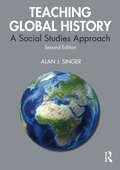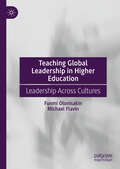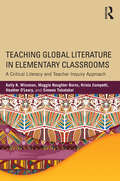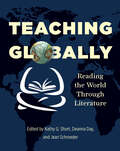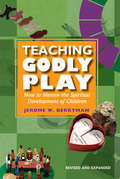- Table View
- List View
Teaching Fractions and Ratios for Understanding: Essential Content Knowledge and Instructional Strategies for Teachers
by Susan J. LamonThe fifth edition of this user-friendly textbook helps mathematics educators explore and explain the complex world of rational numbers. It translates research into usable ideas for the classroom, including reasoning strategies, models, and questioning techniques that promote deep understanding that cannot be achieved by merely practicing fraction computation.Updated throughout with new examples and models from research, each chapter in the new edition incorporates samples of student work for teacher analysis, as well as activities for practicing each thinking strategy, designed to be solved without rules or algorithms, using reasoning alone. All content has been used with students and is presented with the learner in mind, acknowledging the brilliance of students' insights as well as the issues that challenge their understanding. It covers a broad range of topics in the progression from relative thinking to proportional reasoning, including fractions, ratios, rates, operators, measures, percents, and more.For over two decades, Teaching Fractions and Ratios for Understanding has helped elementary and middle school teachers expand their understanding and teaching strategies for rational number topics. The fifth edition is essential reading for mathematics courses, teacher preparation courses, graduate courses preparing researchers in mathematics education, and parents engaged in home schooling.
Teaching Fractions through Situations: A Fundamental Experiment
by Virginia Warfield Nadine Brousseau Guy BrousseauThis work presents one of the original and fundamental experiments of Didactique, a research program whose underlying tenet is that Mathematics Education research should be solidly based on scientific observation. Here the observations are of a series of adventures that were astonishing for both the students and the teachers: the reinvention of fractions and of decimal numbers in a sequence of lessons and situations that permitted the students to construct the concepts for themselves. The book leads the reader through the highlights of the sequence's structure and some of the reasoning behind the lesson choices. It then presents explanations of some of the principal concepts of the Theory of Situations. In the process, it offers the reader the opportunity to join a lively set of fifth graders as they experience a particularly attractive set of lessons and master a topic that baffles many of their contemporaries.
Teaching French Neoclassical Tragedy (Options for Teaching #55)
by Hélène E. Bilis and Ellen McClureTragedy has been reborn many times since antiquity. Seventeenth-century French playwrights composed tragedies marked by neoclassical aesthetics and the divine-right absolutism of the Grand Siècle. But their works also speak to the modern imagination, inspiring reactions from Barthes, Derrida, and Foucault; adaptations and reworkings by Césaire and Kushner; and new productions by francophone and anglophone directors.This volume addresses both the history of French neoclassical tragedy--its audiences, performance practice, and development as a genre--and the ideas these works raise, such as necessity, free will, desire, power, and moral behavior in the face of limited choices. Essays demonstrate ways to teach the plays through a variety of lenses, such as performance, spectatorship, aesthetics, rhetoric, and affect. The book also explores postcolonial engagement, by writers and directors both in and outside France, with these works.
Teaching From the Deep End: Succeeding With Today's Classroom Challenges
by Mr Dominic V. BelmonteEncouraging teachers to reflect on why they chose teaching as a profession, this edition includes suggestions for navigating school politics, job searching, and surviving a "testmania" culture.
Teaching Games and Sport for Understanding
by Shane Pill Linda L. Griffin Gambles, Ellen-Alyssa F.This new book brings together leading and innovative thinkers in the field of teaching and sport coaching pedagogy to provide a range of perspectives on teaching games and sport for understanding. Teaching Games and Sport for Understanding engages undergraduate and postgraduate students in physical education and sport coaching, practicing teachers, practicing sport coaches, teacher educators and coach developers. The contributions, taken together or individually, provide insight, learning and opportunities to foster game-based teaching and coaching ideas, and provide conceptual and methodological clarity where a sense of pedagogical confusion may exist. Each chapter raises issues that can resonate with the teacher and sport practitioner and researcher. In this way, the chapters can assist one to make sense of their own teaching or sport coaching, provide deeper insight into personal conceptualisations of the concept of game-based teaching and sport coaching or stimulate reflections on their own teaching or coaching or the contexts they are involved in. Teaching games and sport for understanding in various guises and pedagogical models has been proposed as leading practice for session design and instructional delivery of sport teaching in PE and sport coaching since the late 1960s. At its core, it is a paradigm shift from what can be described as a behaviourist model of highly directive instruction for player replication of teacher/coach explanation and demonstration to instructional models that broadly are aimed at the development of players self-autonomy as self-regulated learners –‘thinking players’. This innovative new volume both summarises current thinking, debates and practical considerations about the broad spectrumof what teaching games for understanding means as well as providing direction for further practical, pragmatic and research consideration of the concept and its precepts and, as such, is key reading for both undergraduate and postgraduate students of physical education and sport coaching as well as practicing teachers and sport coaches.
Teaching Gender and Sex in Contemporary America
by Kristin Haltinner Ryanne PilgeramThis book providesinnovative pedagogy, theory, and strategies for college and universityprofessors who seek effective methods and materials for teaching about genderand sex to today's students. It provides thoughtful reflections on the newstruggles and opportunities instructors face in teaching gender and sex duringwhat has been called the "post-feminist era. " Building off its predecessor: TeachingRace and Anti-Racism in Contemporary America, this book offerscomplementary classroom exercises for teachers, that foster active andcollaborative learning. Through reflecting on the gendered dimensions ofthe current political, economic, and cultural climate, as well as presentingnovel lesson plans and classroom activities, Teaching Gender and Sex inContemporary America is a valuable resource for educators.
Teaching Gender and Sexuality at School: Letters to Teachers
by Tara GoldsteinIn a set of compelling letters to teachers, Tara Goldstein addresses a full range of issues facing lesbian, gay, bisexual, transgender, and queer (LGBTQ) students and families at elementary and secondary school. Goldstein talks to teachers about how they can support LGBTQ students and families by normalizing LGBTQ lives in the curriculum, challenging homophobic and transphobic ideas, and building an inclusive school culture that both expects and welcomes LGBTQ students and their families. Moving and energizing, Teaching Gender and Sexuality at School provides readers with the knowledge and resources they need to create safer and more positive classrooms and discusses what it takes to build authentic, trusting relationships with LGBTQ students and families.Includes "The Unicorn Glossary" by benjamin lee hicks, the performed ethnography Snakes and Ladders by Tara Goldstein, and the verbatim play Out at School by Tara Goldstein, Jenny Salisbury, and Pam Baer.
Teaching Gender in MINT in der Pandemie: Chancen und Herausforderungen digitaler Transformation (Edition Fachdidaktiken)
by Yves JeanrenaudDer Band widmet sich der Frage, ob und wie sich die Corona-Pandemie auf das Themenfeld Gender in der MINT-Hochschullehre spezifisch auswirkte und weiterhin auswirkt. Dabei werden Aspekte der digitalen Transformation der MINT-Hochschullehre während der Corona-Krise analysiert und Einblicke in die Voraussetzungen, Prozesse und Folgen der Auseinandersetzung mit dem Thema Gender in diesem Zusammenhang beleuchtet.
Teaching Gender?: Sex Education and Sexual Stereotypes (Routledge Library Editions: Education and Gender #21)
by Tricia SziromOriginally published in 1988. This book provides a unique perspective on the creation of gender and the way in which sex education programs in schools contribute to this. Through a series of conversations with young people, a picture is developed of the way in which young women and young men view their own sexuality and that of the opposite sex. The book demonstrates that, in spite of the ‘sexual revolution’, young people’s sexuality is still expressed within traditional gender constraints. The research reveals that, in spite of its ‘radical’ reputation, current sex education policy is consistent with the rest of the school curriculum: in failing to address the links between gender stereotypes and the social construction of sexuality, sex education implicitly and explicitly reinforces traditional attitudes to women’s sexuality. The book provides a conceptual framework for the discussion of the construction of gender and the place of theories of sexuality within this: examples of young people’s attitudes and practice; an historical perspective for and current analysis of the provision of sex education; and, most important, practical strategies for change.
Teaching General Music: Approaches, Issues, and Viewpoints
by Carlos R. Abril Brent M. GaultGeneral music is informed by a variety of teaching approaches and methods. These pedagogical frameworks guide teachers in planning and implementing instruction. Established approaches to teaching general music must be understood, critically examined, and possibly re-imagined for their potential in school and community music education programs. Teaching General Music brings together the top scholars and practitioners in general music education to create a panoramic view of general music pedagogy and to provide critical lenses through which to view these frameworks. The collection includes an examination of the most prevalent approaches to teaching general music, including Dalcroze, Informal Learning, Interdisciplinary, Kodály, Music Learning Theory, Orff Schulwerk, Social Constructivism, and World Music Pedagogy. In addition, it provides critical analyses of general music and teaching systems, in light of the ways children around the world experience music in their lives. Rather than promoting or advocating for any single approach to teaching music, this book presents the various approaches in conversation with one another. Highlighting the perceived and documented benefits, limits, challenges, and potentials of each, Teaching General Music offers myriad lenses through which to re-read, re-think, and re-practice these approaches.
Teaching Generation Text
by Lisa Nielsen Willyn WebbMobilizing the power of cell phones to maximize students' learning power Teaching Generation Text shows how teachers can turn cell phones into an educational opportunity instead of an annoying distraction. With a host of innovative ideas, activities, lessons, and strategies, Nielsen and Webb offer a unique way to use students' preferred method of communication in the classroom. Cell phones can remind students to study, serve as a way to take notes, provide instant, on-demand answers and research, be a great vehicle for home-school connection, and record and capture oral reports or responses to polls and quizzes, all of which can be used to enhance lesson plans and increase motivation. Offers tactics for teachers to help their students integrate digital technology with their studies Filled with research-based ideas and strategies for using a cell phone to enhance learning Provides methods for incorporating cell phones into instruction with a unit planning guide and lesson plan ideas This innovative new book is filled with new ideas for engaging learners in fun, free, and easy ways using nothing more than a basic, text-enabled cell phone.
Teaching Geography Creatively (Learning to Teach in the Primary School Series)
by Stephen ScoffhamTeaching Geography Creatively was Winner of the Geographical Association Gold Award 2014 and Winner of the Geographical Association Silver Award 2017. This fully updated second edition of Teaching Geography Creatively is a stimulating source of guidance for busy trainee and experienced teachers. Packed full of practical approaches for bringing the teaching of geography to life, it offers a range of innovative ideas for exploring physical geography, human geography and environmental issues. Underpinned by the very latest research and theory, expert authors from schools and universities explore the inter-relationship between creativity and learning, and consider how creativity can enhance pupils’ motivation, self-image and well-being. Two brand new chapters focus on creative approaches to learning about the physical world, as well as the value of alternative learning settings. Further imaginative ideas include: games and starter activities as entry points for creative learning how to keep geography messy the outdoors and learning beyond the classroom how to teach geography using your local area the links between geography and other areas of the curriculum looking at geography, creativity and the future fun and games in geography engaging with the world through picture-books teaching about sustainability. With contemporary, cutting-edge practice at the forefront, Teaching Geography Creatively is an essential read for all trainee and practicing teachers, offering a variety of practical strategies to create a fun and stimulating learning environment. In the process it offers a pedagogy that respects the integrity of children as joyful and imaginative learners and which offers a vision of how geography can contribute to constructing a better and more equitable world.
Teaching Geography in Secondary Schools: A Reader
by Maggie SmithA companion to Aspects of Teaching Secondary Geography, Teaching Geography in the Secondary School: A Reader brings together a wide range of key writings that look at central issues, debates and ideas surrounding geography education today. It encourages students to reflect critically upon the issues in order to develop their understanding of these issues and to consider the implications for their classroom practice.
Teaching Geology Using the History and Philosophy of Science: Enhancing Conceptual Understanding (Science: Philosophy, History and Education)
by Glenn DolphinThis book provides a case study on how to design and build an introductory geology course for non-science majors. The book presents a foundation with the status of geoscience education and research in geoscience conceptual development as a backdrop for the design process. It then describes the instructional goal-setting process and development of the structural components of the course based on the determined goals. The book presents the three historical narratives (the earth is a historical entity, the earth is very old, and the earth is dynamic) that form the foundation of instruction. It also describes examples of the implicit, explicit, and reflective treatments of the nature of science to help student develop a better sense of the process of geology. Finally, the book gives preliminary results from some innovative approaches to research on student learning within the domains of geological content knowledge and NOS content knowledge within the course.
Teaching Gifted Children 4-7: A Guide for Teachers
by Valsa KoshyThis book offers practical guidelines on how to identify gifted and talented young children and looks at ways to enhance their learning opportunities. Provided are a wealth of practical, tried and tested strategies that readers will be able to use in their classrooms with confidence. It includes advice on how to create the right classroom environment, guidance on how to assess and record children's talents, a list of suggested appropriate resources, and help with planning the curriculum. The emphasis is on creating a classroom environment that encourages children to be engaged in higher order thinking skills, exploration and creativity; the importance of play and the role of questioning is highlighted. Using case studies of young gifted children and rooted in theoretically sound principles, this book makes a significant contribution to the learning and teaching of younger children. Teachers, teaching assistants, advisers, Gifted and Talented Coordinators and training teachers will find this book relevant to their needs.
Teaching Gifted Children with Special Educational Needs: Supporting dual and multiple exceptionality
by Diane MontgomeryChildren with both giftedness and special educational needs are often found in the mainstream classrooms. This essential resource provides an overview of existing knowledge about dual and multiple exceptionality (DME), examining the needs of gifted and talented children from both the class teacher’s and SENCo’s perspectives. Diane Montgomery explores both the specialist interventions that some children will need at least for part of their school life, as well as the general inclusive provision that every school can develop to meet the needs of all children. Focusing on evidence-based identification throughout, chapters in this accessible book cover: An analysis of the terms ‘giftedness and talent’ and the different methods that can be used for identifying them and assessing their limitations Identifying and supporting a range of difficulties, syndromes and disorders such as dyslexia, dyscalculia, DCD, ASD, ADHD and SEBD How to manage classroom behaviour, improve school ethos and create a DME-friendly school through inclusive teaching and learning This invaluable resource will assist you in creating a DME friendly school, help to integrate learners with a range of difficulties and enable them and others to learn.
Teaching Gifted Children: Success Strategies for Teaching High-Ability Learners
by Jeff Danielian Elizabeth Fogarty C. FugateFrom the pages of Teaching for High Potential, a quarterly publication of the National Association for Gifted Children, this collection of articles is sure to be of use to any educator of high-ability students. Topics included range from instructional methods across all content areas, including tips and tools for reading and vocabulary instruction, integrating STEM content, and engaging students in math, to identification, differentiation, and addressing gifted students' social-emotional needs. Articles also delve into current issues pertinent to the field of gifted education and this unique group of students, including underachievement and underrepresented minority populations, as well as new classroom strategies such as Makerspaces and teaching growth mindset. This resource can be used to enhance a classroom lesson, guide curriculum development, or supplement professional development. The featured articles are unique, well written for the audience, and selected by reviewers who understand what teachers need.
Teaching Gifted Children: Success Strategies for Teaching High-Ability Learners
by Jeff Danielian Matthew Fugate Elizabeth A. FogartyFrom the pages of Teaching for High Potential, a quarterly publication of the National Association for Gifted Children, this collection of articles is sure to be of use to any educator of high-ability students. Topics included range from instructional methods across all content areas, including tips and tools for reading and vocabulary instruction, integrating STEM content, and engaging students in math, to identification, differentiation, and addressing gifted students' social-emotional needs. Articles also delve into current issues pertinent to the field of gifted education and this unique group of students, including underachievement and underrepresented minority populations, as well as new classroom strategies such as Makerspaces and teaching growth mindset. This resource can be used to enhance a classroom lesson, guide curriculum development, or supplement professional development. The featured articles are unique, well written for the audience, and selected by reviewers who understand what teachers need.
Teaching Gifted Learners in STEM Subjects: Developing Talent in Science, Technology, Engineering and Mathematics (Routledge Research in Achievement and Gifted Education)
by Keith S. Taber Manabu Sumida Lynne McClureThis book offers an overview of programmes designed to support the learning of gifted and talented students in STEM subjects, both to allow them to meet their potential and to encourage them to proceed towards careers in STEM areas. The chapters from a range of national contexts report on perspectives, approaches and projects in gifted education in STEM subjects. These contributions provide a picture of the state of research and practice in this area, both to inform further research and development, and to support classroom teachers in their day-to-day work. Chapters have been written with practitioners in mind, but include relevant scholarly citations to the literature. The book includes some contributions illustrating research and practice in specific STEM areas, and others which bridge across different STEM subjects. The volume also includes an introductory theoretical chapter exploring the implications for gifted learners of how 'STEM' is understood and organized within the school curriculums.
Teaching Gifted and Talented Pupils in the Primary School: A Practical Guide
by Chris Smith′This book is a joy to read. It is full of good sense and, what teachers always hope to find, lots of good, practical ideas...This is a valuable resource and every staffroom should have a copy′ - Gifted and Talented Update ′Smith′s research interests in inclusive and gifted education are reflected in her publications and this book is no exception. This is essentially a user-friendly practitioner′s text, aimed at primary school educators...I would recommend this as a useful addition to the practising teacher′s repertoire of resource texts′ Susen Smith, former primary school teacher ′The suggestions here, many of them photocopiable, are clearly tried and tested. All primary teachers will find them helpful′ - Michael Duffy, The Times Educational Supplement `A very useful aid to any staff room bookshelf. Easy to read, use and understand- National Association of Gifted Children Newsletter `A must read for all teachers. This book not only sets out very clearly the needs of Able Gifted and Talented pupils, but also helps teachers reappraise their classroom practice and the role of the learner′ - Johanna M Raffan, Director of NACE, National Association for Able Children How can we provide challenges for the gifted and talented primary school pupil in an inclusive classroom setting? Using tried and tested examples, this book shows the busy teacher how to challenge able children in their mixed-ability class - where time and resources are usually limited. The practical tasks will show you how carefully designed activities can cater for a range of abilities. The book has sections on: - creating a working environment that helps more able pupils to thrive; - varying the way you ask pupils questions; - thinking about multiple intelligences and ways to develop them; - developing different levels of challenge in classroom activities; - allowing pupils some choice in the activities they do; - advice on how to run whole-class research projects. A glossary of key terms and a range of photocopiable material are included. Class teachers, GATCOs, Teaching Assistants, Learning Support Teachers, trainee teachers and LEA advisers looking for practical teaching ideas to challenge gifted children will find this book ideal for use in their settings.
Teaching Global History: A Social Studies Approach
by Alan J. SingerThis updated edition of Teaching Global History challenges prospective and beginning social studies teachers to formulate their own views about what is important to know in global history and why. This essential text explains how to organize curriculum around broad social studies concepts and themes, as well as student questions about humanity, history, and the contemporary world. All chapters feature lesson ideas, a sample lesson plan with activity sheets, primary source documents, and helpful charts, graphs, photographs, and maps. This new edition includes connections to the C3 framework, updates throughout to account for the many shifts in global politics, and a new chapter connecting past to present through current events and historical studies in ways that engage students and propel civic activism. Offering an alternative to pre-packaged textbook outlines and materials, this text is a powerful resource for promoting thoughtful reflection and debate about what the global history curriculum should be and how to teach it.
Teaching Global Leadership in Higher Education: Leadership Across Cultures
by Michael Flavin Funmi OlonisakinThis book answers a need for pedagogic guidance and instruction in designing, implementing and evaluating global leadership as an academic subject. The book understands global leadership as a social practice and as a comparative subject, analysing how leadership is conceived of and practised in different countries and cultures. At the same time, the authors see global leadership from a ‘grand challenges’ perspective, engaging with the key issues of the age, some of which are identified through the United Nations’ Sustainable Development Goals. By these means, the book proposes a distinctive global leadership curriculum with potential to aggregate and unify different approaches to the subject. The book provides the conceptual underpinning, the multicultural perspective and the practical guidance to help universities worldwide in designing and developing curricula in global leadership, a subject of increasing interest in the twenty-first century as the geopolitical, even existential challenges of the age require both research and practice which transcends the boundaries of both nations and of academic disciplines. The book will also be of interest to researchers and practitioners in the fields of educational development and pedagogy.
Teaching Global Literature in Elementary Classrooms: A Critical Literacy and Teacher Inquiry Approach
by Kelly K. Wissman Maggie Naughter Burns Krista Jiampetti Heather O'Leary Simeen TabatabaiDemonstrating the power of teaching global literature from a critical literacy perspective, this book explores the ways that K-6 educators can infuse diverse texts into their classrooms and find support for their endeavours in teacher inquiry communities. Through carefully analyzed, ethnographically informed portraits of classroom life alternating with teachers’ own accounts of their teaching and learning experiences, it demonstrates how students are moved to question, debate, and take action in response to global texts. This multi-vocal work both emerges from and responds to tensions and debates related to the purpose and practice of literature education in a time of Common Core State Standards.
Teaching Globally: Reading the World through Literature
by Kathy Short Deanna Day Jean SchroederWith the world visibly present in students' lives through technology, mass and social medias, economic interdependency, and global mobility, it is more important than ever to develop curriculum that is intercultural. In Teaching Globally: Reading the World Through Literature, a community of educators show us how to use global children's literature to help students explore their own cultural identities. Edited by Kathy Short, Deanna Day, and Jean Schroder, this book explains why global curriculum is important and how you can make space for it within district and state school mandates. Teaching Globally is built around a curriculum framework developed by Short and can help teachers integrate a global focus into existing literacy and social studies curricula, evaluate global resources, guide students as they investigate cross-cultural issues, and create classroom activities with an intercultural perspective. Filled with vignettes from K-8 urban, suburban, and rural schools that describe successes and struggles, Teaching Globally aims to integrate global literature into classrooms and challenge students to understand and accept those different from themselves. The book also includes extensive lists of recommendations, websites, professional books, and an appendix of global text sets as mentioned by the authors. '
Teaching Godly Play: How to Mentor the Spiritual Development of Children
by Jerome W BerrymanA way to engage kids with scripture stories, based on the Montessori method, to build a Christian education that endures beyond Sunday school. Children learn through play. Understanding this basic premise, Rev. Jerome Berryman adapted techniques from the Montessori teaching method to develop an imaginative approach to telling scripture stories to children in a way that is at once playful and meaningful to them. Outlining specific storytelling techniques and demonstrating how to use story figures and other creative activities, Rev. Berryman models how to awaken children’s curiosity and imagination to create a personal experience of the Gospel. Incorporating up-to-date research in childhood development and instruction, Teaching Godly Play is a practical and effective handbook for religious educators to facilitate a warm and compelling experience of the scriptures for children of all ages.
